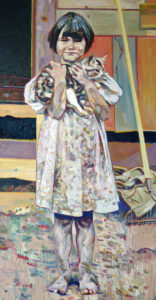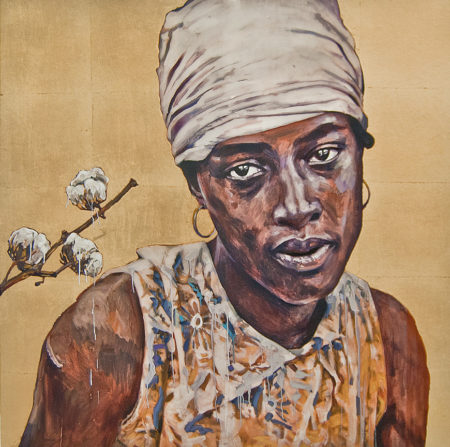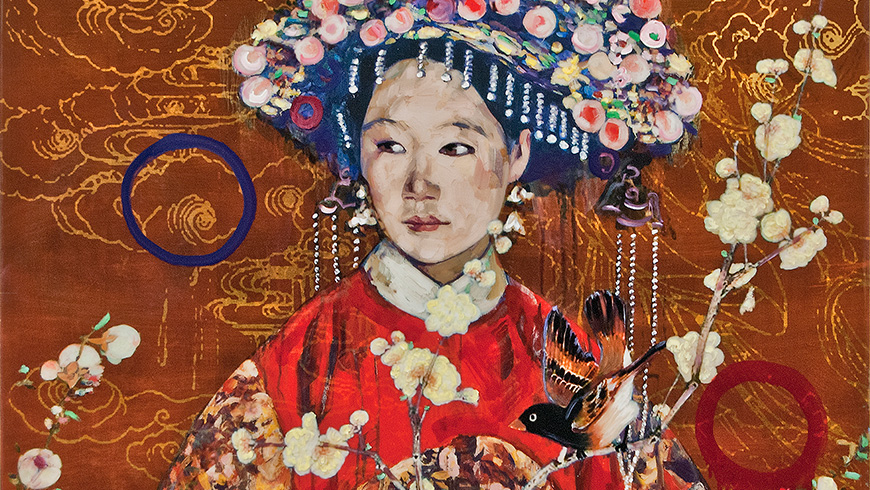When the president baffles, painter Hung Liu—who is on a lifelong quest for isonomy and compassion-—is spurred to counter with one of her indelible rebranded moments in history.
“It allows me the perspective to understand this country, and that understanding is why I’m here,” she explained recently from her Bay Area studio. “America is much more complex and interesting than the current resident of the White House can grasp. History is more important than the future, especially forgotten history, stories of anonymous people.”
The Chinese immigrant has always used the muse of misguided authority to inform her work. Social realists like Liu are critical of the social constructs that maintain the everyday conditions of the working class and the poor.

“Barefoot Girl with Cat” by Hung Liu. Mixed media on panel, 80 x 40in
She knows her subjects more intimately than many artists. Born in Changchun, China, in 1948, Liu was raised in the communist regime of Mao Zedong. She labored away her early 20s in rice and wheat fields as part of an agrarian re-education demanded by Mao’s Cultural Revolution.
She took along a camera, loaned to her by a young Chinese man who was being sent to a military work camp during the same period.
“He would not have been allowed to keep a camera there, so he gave it to me,” she recalled. “I learned to use it to take many photos of the peasants in the village I was sent to in 1968.”
The camp life left a mark long after Liu returned to Beijing and completed her art and education degree. A need to relate her experience began taking on fervor after leaving her country in 1984 to begin study at the University of California, San Diego with art world luminaries like Allan Kaprow and Moira Roth.
Her revolutionary work began to marinate soon after finding a cache of historical commercial-studio photographs of women in pre-revolutionary China, the subjugated classes of prostitutes, refugees, street performers, soldiers, laborers and prisoners.
Such historic photos launched a new direction.
Using an exacting process of elimination and addition, Liu began to introduce the image to numerous processes, from linseed oil to more tactile influences in an effort, as she has said, to “uncover the cultural and personal narratives fixed—but often concealed—in the photographic instant.” Her techniques allowed her to toy with the image and coax forth “the ghosts of history to the present … a weeping realism that surrenders the erosion of memory to the passage of time, while also bringing faded photographic images vividly to life as rich, facile paintings.”
Particularly compelling are the eyes of the people in her images, an intentional influence of her cultural heritage.
“In China we say that the eyes are windows to the soul. I paint the eyes of my subjects differently, as their souls are different.”
The trained muralist who left China with $20 and two suitcases would return as an iconic artist—hailed by The Wall Street Journal as “the greatest Chinese painter in America—to the laborers and concubines there. Later, using haunting images from the American Dustbowl shot by Dorothea Lange—and applying her evolved finesse—made her a Western star of the voiceless too, challenging views of culture, identity, gender and memory.”
Her interpretations of history’s ghosts can now be seen in more than 40 major museums in the U.S. from the Metropolitan Museum of Art to the San Francisco Museum of Modern Art.
Dorothy Moss, curator of the Smithsonian National Portrait Gallery, on Artnet.com, named Liu as one of the last century’s most influential artists, noting her “… commitment to complicating the dominant narratives of history and making absence visible through work that is both searing and transcendent.” In a campaign by the National Museum of Women in the Arts conducted by The Washington Post, Liu was named one of the “5 Women Artists” alongside Mexican treasure Frida Kahlo and African American painter Amy Sherald.
Liu’s paintings, jacquard tapestries, prints, and installations are an alchemy of lithography, etching, monotype, photography and experimental printmaking. She received a National Award for Lifetime Achievement in Printmaking, which Liu equates to creating poetry.
“To make her prints, Liu uses an array of printing and collage techniques, developing highly textured surfaces, veils of color, and screens of drip marks that transform the figures in each composition,” noted a promotional piece by the National Museum of Women in the Arts, which is hosting a solo exhibition of Liu’s prints and tapestries through July. Describing Liu’s work as “palpable,” the piece continued: “She emphasizes the spontaneity of the layering process, which allows each image to build organically with each successful layer.”

“Lady Cotton (Gold) SI” by Hung Liu. Monotype with gold leaf, 26 x 26 in. image, 32 x 31 in. paper. Courtesy Gail Severn Gallery
In conjunction with Liu’s exhibition in New York City, in late July Gail Severn Gallery in Ketchum will host “Hung Liu: Women.”
Severn, who has represented Liu for more than a decade, said the upcoming exhibition “…is comprised of her newest oils and mixed media images based on the historical photos of Dorothea Lange. As a natural extension of her previous work, Liu interprets Lange’s photos as they relate to the universal issues of poverty, displacement, and survival.”
Liu, who resides in Oakland, Calif., is also a Professor Emerita at Mills College, where she has taught since 1990. She is an artist who has studied her own motivations deeply enough to be able to guide her students through lively explorations of their developing crafts.
Liu said that before she begins a painting, she shuffles her collection of photos, “just looking them over and over again.” She takes them on trips, “especially long flights, from California to New York, from San Francisco to Beijing.” She also brings a sketchbook to jot down her “what ifs,” like how something might appear if made 8 feet tall.
“Look closely at the world around you and use drawing and photography to visualize new perspectives,” she said.
Asked whom she counted as her most influential teachers, the dichotomy was consistent with her life.
“Miss Chu Jinglan, my English teacher in Beijing; Miss Xia Xiurong, my Chinese literature teacher; Miss Wang Qingyi, my physics teacher; Allan Kaprow, the inventor of Happenings in the 1950s in New York, when I attended UCSD; Chinese peasants; revolution; and America.“
Asked what was on the canvas before her during this interview, she described a scene that could be anywhere in America currently.
“A vast Idaho landscape, from a photograph by Dorothea Lange in the 1930s, that is deserted, lined in the foreground with a row of empty mailboxes. Tree stumps look as if they have been burned,” she said. “It’s an unfinished painting, but so far it depicts a beautiful but ravaged land.”


